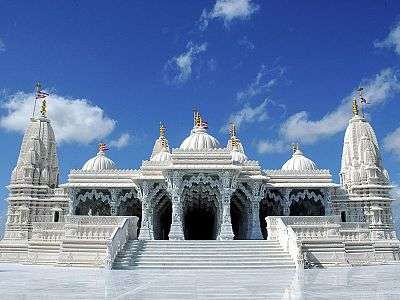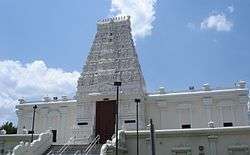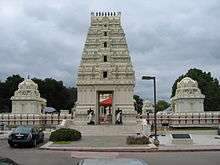Hinduism in the United States
| Total population | |
|---|---|
|
3,230,000 (2017) 1% of the U.S. population[1] Pew Research Center | |
| Religions | |
| Hinduism | |
| Languages | |
| Sanskrit (Liturgical language) · American English · Hindi · Bengali · Tamil · Punjabi · Gujarati · Telugu · Malayalam · Kashmiri · Sindhi · Dogri · Kannada · Oriya · Kutchi · Tulu · Assamese · Konkani · Nepali · Marathi · Maithili · Santali · Kokborok · Bhil · Meitei · Dzongkha · Malay · Javanese · Balinese · Cham · Caribbean Hindustani · Caribbean English · Sranan Tongo · Mauritian Creole · Mauritian Bhojpury · Fiji Hindi · British English · Indian English · Indian French · Portuguese · Dutch · other South Asian languages · other languages | |
| Related ethnic groups | |
| Sikhism in the United States, Buddhism in the United States |
Hinduism is a minority religion in the United States. The vast majority of American Hindus are immigrants from South Asia (mainly India, Nepal, Sri Lanka, and Bangladesh, some from Bhutan, Maldives, Afghanistan, Pakistan, and Myanmar), Indonesia (mainly Bali and Java), the Caribbean (mainly Trinidad and Tobago, Guyana, Suriname, and Jamaica), Fiji, Africa (mainly Southern Africa and Eastern African), and Mauritius and other countries and their descendants. Additionally, the United States has a number of converts to Hinduism. There are also about 900 ethnic Cham people of Vietnam, living in America. 55% of whom are Hindus. They are one of the few remaining non-Indic Hindus in the World.[2]
While there were isolated sojourns by Hindus in the United States during the 19th century, Hindu presence in the United States was extremely limited until the passage of the Immigration and Nationality Act of 1965.
Currently, Hindu-Americans hold the highest education levels among all religious communities in the United States, though this is mostly due to immigration policies that favor educated Hindus.[3][4] Many concepts of Hinduism, such as karma, reincarnation and yoga, have entered into mainstream American vernacular.[5] According to Pew Forum on Religion and Public Life survey of 2009, 24% of Americans believe in reincarnation, a core concept of Hinduism.[6][7]
Demographics
The United States Department of State's Religious Freedom Report 2004[8] found some 1.5 million adherents of Hinduism, corresponding to 0.50% of the total population. The Hindu population of USA is the world's eighth-largest; 10% of Asian Americans who together account for 5.8% of US population, are followers of the Hindu faith.[9]
Hindus are the most educated religious community in the world. Even todays computers are based on our sanskrit language. The four Vedas followed by us are the ultimate source of knowledge </ref>[10][11] But statistically in USA, American Hindus have the highest rates of educational attainment and household income among all religious communities, and tend to have lower divorce rates. 48% of American Hindus hold a post-graduate degree.[12][13] According to a study by the Pew Research Center's Forum on Religion and Public Life in 2012, 48% of American Hindus have a household income of $100,000 or more, and 70% make at least $75,000.[3][4]
History
Anandibai Joshi is believed to be the first Hindu woman to set foot on American soil, arriving in New York in June 1883 at the age of 19. She graduated with an MD from the Women's Medical College of Pennsylvania on 11 March 1886, becoming the first female of South Asian origin to graduate with a degree in Western medicine from the United States. Joshi returned to India in late 1886 but died within months of her return.[14]

One of the first major discussions of Hinduism in the United States was Swami Vivekananda's address to the World's Parliament of Religions in Chicago in 1893. He spent two years in the United States, and lectured in several cities including Detroit, Boston, and New York. In 1902 Swami Rama Tirtha visited the US for about two years lecturing on the philosophy of Vedanta.[15] In 1920 Paramahansa Yogananda was India's delegate at the International Congress of Religious Liberals held in Boston.
Prior to 1965, Hindu immigration to the United States was minuscule and isolated, with fewer than fifty thousand Indians immigrating before 1965. It is worth noting that although most of these immigrants were Punjabi Sikhs, they were incorrectly and derogatorily referred to as "Hindoo" by many Americans, as well as in some official immigration documents.[16] The Bellingham Riots in Bellingham, Washington on September 5, 1907 epitomized the low tolerance in the USA for Indians and Hindus. In the 1923 case United States v. Bhagat Singh Thind, the Supreme Court ruled that Thind and other South Asians were not "free white persons" according to a 1790 federal law that stated that only white immigrants could apply for naturalized citizenship.[17] The Immigration Act of 1924 prohibited the immigration of Asians such as Middle Easterners and Indians. This further prevented Hindus from immigrating to the United States.[18] Despite such events, some people, including professionals, stayed and worked until the Immigration and Nationality Services (INS) Act of 1965 was passed. This opened the doors to Hindu immigrants who wished to work and start families in the United States. It included Hindu preachers as well, who spread awareness of the religion among the people who had little or no contact with it.
Also during the 1960s, Hindu teachers found resonance in the US counter-culture, leading to the formation of a number of Neo-Hindu movements such as the International Society for Krishna Consciousness founded by Swami Prabhupada. People involved in the counter-culture such as Ram Dass, George Harrison, and Allen Ginsberg were influential in the spread of Hinduism in the United States. Ram Dass was a Harvard professor known as Richard Alpert and after being fired from Harvard was receiving a lot of media coverage. He traveled to India and studied under Neem Karoli Baba and came back to the west as a Hindu teacher and changed his name to Ram Dass which means servant of Rama (one of the Hindu gods). A student of Ram Dass, Jeffery Kagel, devoted his life to Hinduism in the sixties and is now making many CDs chanting the sacred mantras or spiritual verses. He has been very successful and is considered the rock star of yoga. George Harrison was a member of The Beatles which in its peak of popularity was receiving more media coverage than any other band in the world. He became a devotee of Swami Prabhupada who is the founder of ISKCON (mentioned above). George Harrison started to record songs with the words "Hari Krishna" in the lyrics and was widely responsible for popularizing Hinduism in America with the younger generation of the time. Allen Ginsberg, the author of Howl, became a figure in the sixties that was also heavily involved with Hinduism and it was said that he chanted "Om" at The Human Be-in of 1967 for hours on end. Other influential Indians of a Hindu faith are Chinmoy and Maharishi Mahesh Yogi.
A joint session of the United States Congress was opened with a prayer in Sanskrit (with some Hindi and English added), read by Venkatachalapathi Samudrala, in September 2000, to honour the visit of Indian Prime Minister Atal Bihari Vajpayee. The historic gesture was an initiative by Ohio Congressman Sherrod Brown who requested the US Congress House Chaplain to invite the Hindu priest from the Shiva Vishnu Hindu Temple in Parma, Ohio.[19] Another Hindu prayer was read in the United States Senate on July 12, 2007, by Rajan Zed, a Hindu chaplain from Nevada.[20] His prayer was interrupted by a couple and their daughter who claimed to be "Christian patriots", which prompted a criticism of candidates in the upcoming presidential election for not criticizing the remarks.[21] In October 2009, President Barack Obama lit a ceremonial Diwali lamp at the White House to symbolise victory of light over darkness.
92,323 exiled Bhutanese refugee have been resettled in USA since 2008 (As per the date of Feb, 2017) and many more Bhutanese refugee are resettling in United State of America continuously. Hinduism is the major religion of Bhutanese refugees who resettle in USA.[22][23]
Hindu temples
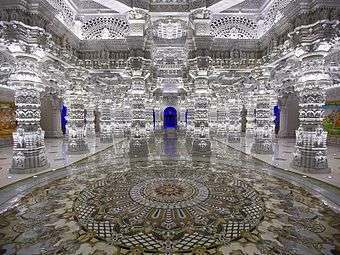
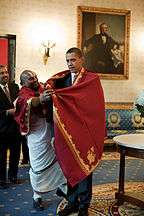
The Vedanta Society was responsible for building some early temples in United States starting in 1906, but they were not formal temples. Earliest traditional Mandir in the United States is Shiva Murugan Temple, Concord, CA (1957)[24] known as Palanisamy Temple, it is one of the few temples that is run by public by elected members. The Maha Vallabha Ganapathi Devastanam owned by the Hindu Temple Society of North America in Flushing, New York City was consecrated on July 4, 1977. This temple recently underwent significant expansion and renovation.[25]
Today there are over 450 Hindu Temples across the United States,[26] spread across the country, with a majority of them situated on the east coast centred around the New York region which alone has over 135 temples [27] the next largest number being in Texas with 28 Temples [28] and Massachusetts with 27 temples.[29]
Other prominent temples include the Malibu Hindu Temple, built in 1981 and located in Calabasas, is owned and operated by the Hindu Temple Society of Southern California. The temple is near Malibu, California. Apart from these, Swaminarayan temples exist in several cities across the country with a sizable following.
The oldest Hindu Temple in Texas is the Shree Raseshwari Radha Rani temple at Radha Madhav Dham, Austin.[30] The temple, established by Jagadguru Shree Kripaluji Maharaj is one of the largest Hindu Temple complexes in the Western Hemisphere,[31] and the largest in North America.[32][33][34]
In Tampa, South Florida, Sri Vishnu Temple is established before about 160 years

Parashakthi Temple[35] in Pontiac, Michigan is a tirtha peetham in the west for Goddess "Shakthi" referred to as the "Great Divine Mother" in Hinduism. The Temple was envisioned by Dr. G Krishna Kumar in a deep meditative kundalini experience of "Adi Shakthi" in 1994.[36]
Akshardham in Robbinsville, New Jersey is one of the largest stone Hindu temples in the United States.[37]
The Indian American Cultural Center opened on March 9, 2002, in Merrillville, Northwest Indiana. It was in 2010 on June 18 that the temple was finalized and opened, The Bharatiya Temple of Northwest Indiana. This temple is adjacent to the Cultural Center. In the native way of Hinduism, one would never see different sectarian groups worship in one temple. The Bharatiya Temple is unique in its own way by allowing different sectarian groups to worship together. The Bharatiya Temple has four different Hindu groups as well as a Jain group.[38]
There are many Hindu temples in the United States, and too many to be listed.
Hinduism in United States Territories
See also
- Californian Hindu textbook controversy
- Category:Converts to Hinduism
- Federation of Tamil Sangams of North America
- Hindu American Foundation
- Hindu denominations
- Hindu Temple Society of North America (Ganesh Temple, Queens)
- Hindu University of America
- Hinduism in Los Angeles
- Hinduism in the West
- Hinduism Today
- Invading the Sacred
- Persecution of Hindus
- Hinduism in Guyana(Country)
- List of Hindu temples in the United States
- Parliament of the World's Religions
- Sanskrit in the West
- United States India Political Action Committee (USINPAC)
- Encyclopedia of Hinduism
- North American Bengali Conference
References
- ↑ "2014 Religious Landscape Study -- Pew Forum on Religion & Public Life". Retrieved 15 May 2015.
- ↑ https://joshuaproject.net/people_groups/11688/US
- 1 2 "Hindu-Americans Rank Top in Education, Income". Retrieved Dec 1, 2012.
- 1 2 "Hindu-Americans Rank Top in Education, Income". Retrieved Dec 1, 2012.
- ↑ "Americans turn to Hindu beliefs". The Times Of India. August 18, 2009. Retrieved Dec 1, 2012.
- ↑ "25 percent of US Christians believe in reincarnation. What's wrong with this picture?". Retrieved Dec 1, 2012.
- ↑ "We Are All Hindus Now". Retrieved 11 July 2018.
- ↑ International Religious Freedom Report 2004
- ↑ "Asian Americans: A Mosaic of Faiths". The Pew Forum on Religion & Public Life. Pew Research Center. 19 July 2012. Retrieved 13 October 2012.
- ↑ "Which Religious Groups are the Most Educated? - World Religion News". worldreligionnews.com. 15 December 2016.
- ↑ "Hindus least educated religious group in world, says survey". hindustantimes.com. 14 December 2016.
- ↑ "Study Shows, Hindus Have Lowest Divorce Rate and Highest Education Level in America". The Chakra. June 13, 2011. Retrieved May 28, 2012.
- ↑ "US Hindus have higher education and lowest divorce rate". The Global Indian. Retrieved May 28, 2012.
- ↑ "Historical Photos Depict Women Medical Pioneers". Public Radio International. 12 July 2013. Retrieved 29 October 2013.
- ↑ Arora, R.K. (1978), Swami Ram Tirath, his life and works, page 56, Rajesh Publications, New Delhi, India
- ↑ Chan, Sucheng. Asian Americans: An Interpretive History. p. 75.
- ↑ Coulson, Doug (2015). "British Imperialism, the Indian Independence Movement, and the Racial Eligibility Provisions of the Naturalization Act: United States v. Thind Revisited". Georgetown Journal of Law & Modern Critical Race Perspectives. 7: 1–42. SSRN 2610266.
- ↑ Mann, Numrich, Williams, Gurinder, Paul, Raymond (2007). Buddhists, Hindus and Sikhs in America : A Short History. Cary, NC, USA: Oxford University Press. pp. 44–45.
- ↑ For the first time, a Hindu priest will pray before US Congress, rediff.com, 14 September 2000.
- ↑ "California Senate opened with Hindu prayer for first time". Asian Tribune. 2007-08-29. Retrieved 2008-07-24.
- ↑ Boorstein, Michelle (2007-07-27). "Hindu Groups Ask '08 Hopefuls to Criticize Protest". The Washington Post.
- ↑ "Nepali-speaking Bhutanese (Lhotsampa) Cultural Profile". Retrieved 5 March 2015.
- ↑ "Where in US and elsewhere Bhutanese refugees from Nepal resettled to". thehimalayantimes.com. 6 February 2017.
- ↑ "Hinduism in America". www.pluralism.org. Retrieved 2015-10-12.
- ↑ Official website of the Flushing temple.
- ↑ Hari Iyer. "Global Hindu Temples directory ~ 2000 Temples in 50 + countries. - All Hindu Temples - America". All Hindu Temples. Retrieved 5 March 2015.
- ↑ Hari Iyer. "Global Hindu Temples directory ~ 2000 Temples in 50 + countries. - All Hindu Temples - New York - America". All Hindu Temples. Retrieved 5 March 2015.
- ↑ Hari Iyer. "Global Hindu Temples directory ~ 2000 Temples in 50 + countries. - All Hindu Temples - Texas - America". All Hindu Temples. Retrieved 5 March 2015.
- ↑ Hari Iyer. "Global Hindu Temples directory ~ 2000 Temples in 50 + countries. - All Hindu Temples - Massachusetts - America". All Hindu Temples. Retrieved 5 March 2015.
- ↑ India today international. Volume 1, Issues 1–8. Living Media International. 2002.
- ↑ Vedic Foundation Inaugurated at Barsana Dham, Austin Archived 2011-08-18 at the Wayback Machine.. Retrieved Dec 15th, 2011.
- ↑ Ciment, J. 2001. Encyclopedia of American Immigration. Michigan: M.E. Sharpe
- ↑ Hylton, H. & Rosie, C. 2006. Insiders' Guide to Austin. Globe Pequot Press.
- ↑ Mugno, M. & Rafferty, R.R. 1998. Texas Monthly Guidebook to Texas. Gulf Pub. Co.
- ↑ "Parashakthi (Eternal Mother) Temple". Archived from the original on 2012-03-23.
- ↑ "Honoring the eternal Divine Mother". India Abroad. 2011-12-30.
- ↑ Kuruvilla, Carol. "PHOTOS: Stunning Hindu temple in New Jersey is one of the largest in America - NY Daily News". nydailynews.com.
- ↑ Pati, George. "Temple and Human Bodies: Representing Hinduism". International Journal of Hindu Studies. 15 (2): 191–207. doi:10.1007/s11407-011-9103-x. Retrieved 30 January 2014.
- ↑ http://www.humantruth.info/guam.html
Further reading
- Bhatia, Sunill. (2007). American Karma: Race, Culture, and Identity in the Indian Diaspora. ISBN 0-8147-9959-0.
External links
- The Council of Hindu Temples of North America (CHTNA)
- Hindu Youth Network
- Hindu Temples Directory, Showing All Temples in America on a Google Map
- Hindu Temples in USA
- Vivekananda Vedanta Society-Chicago
- State-wise list of Hindu Temples in USA with photos and addresses
- South Asian Pioneers in California, 1899–1965
- Parashakthi Eternal Mother Temple




